Related Research Articles

Amblygonite is a fluorophosphate mineral, (Li,Na)AlPO4(F,OH), composed of lithium, sodium, aluminium, phosphate, fluoride and hydroxide. The mineral occurs in pegmatite deposits and is easily mistaken for albite and other feldspars. Its density, cleavage and flame test for lithium are diagnostic. Amblygonite forms a series with montebrasite, the low fluorine endmember. Geologic occurrence is in granite pegmatites, high-temperature tin veins, and greisens. Amblygonite occurs with spodumene, apatite, lepidolite, tourmaline, and other lithium-bearing minerals in pegmatite veins. It contains about 10% lithium, and has been utilized as a source of lithium. The chief commercial sources have historically been the deposits of California and France.
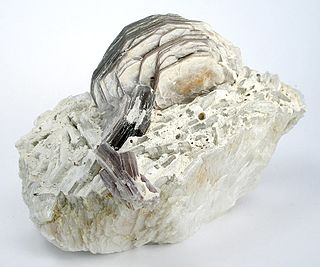
Lepidolite is a lilac-gray or rose-colored member of the mica group of minerals with chemical formula K(Li,Al)3(Al,Si,Rb)4O10(F,OH)2. It is the most abundant lithium-bearing mineral and is a secondary source of this metal. It is the major source of the alkali metal rubidium.
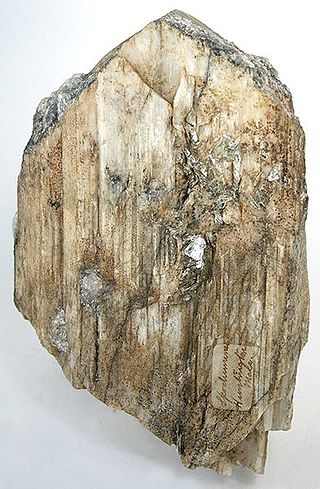
Spodumene is a pyroxene mineral consisting of lithium aluminium inosilicate, LiAl(SiO3)2, and is a source of lithium. It occurs as colorless to yellowish, purplish, or lilac kunzite (see below), yellowish-green or emerald-green hiddenite, prismatic crystals, often of great size. Single crystals of 14.3 m (47 ft) in size are reported from the Black Hills of South Dakota, United States.

Petalite, also known as castorite, is a lithium aluminum phyllosilicate mineral LiAlSi4O10, crystallizing in the monoclinic system. Petalite occurs as colorless, pink, grey, yellow, yellow grey, to white tabular crystals and columnar masses. It occurs in lithium-bearing pegmatites with spodumene, lepidolite, and tourmaline. Petalite is an important ore of lithium, and is converted to spodumene and quartz by heating to ~500 °C and under 3 kbar of pressure in the presence of a dense hydrous alkali borosilicate fluid with a minor carbonate component. Petalite (and secondary spodumen formed from it) is lower in iron than primary spodumene, making it a more useful source of lithium in, e.g., the production of glass. The colorless varieties are often used as gemstones.
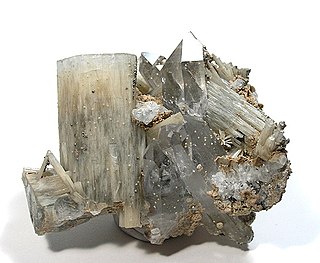
Zinnwaldite, KLiFeAl(AlSi3)O10(OH,F)2, potassium lithium iron aluminium silicate hydroxide fluoride is a silicate mineral in the mica group. The IMA status is as a series between siderophyllite (KFe2Al(Al2Si2)O10(F,OH)2) and polylithionite (KLi2AlSi4O10(F,OH)2) and not considered a valid mineral species.

Pezzottaite, marketed under the name raspberyl or raspberry beryl, is a mineral species first recognized by the International Mineralogical Association in September 2003. Pezzottaite is a caesium analogue of beryl, a silicate of caesium, beryllium, lithium and aluminium, with the chemical formula Cs(Be2Li)Al2Si6O18. Named after Italian geologist and mineralogist Federico Pezzotta, pezzottaite was first thought to be either red beryl or a new variety of beryl ("caesium beryl"); unlike actual beryl, however, pezzottaite contains lithium and crystallizes in the trigonal crystal system rather than the hexagonal system.

Glaucophane is the name of a mineral and a mineral group belonging to the sodic amphibole supergroup of the double chain inosilicates, with the chemical formula ☐Na2(Mg3Al2)Si8O22(OH)2.

Elbaite, a sodium, lithium, aluminium boro-silicate, with the chemical composition Na(Li1.5Al1.5)Al6Si6O18(BO3)3(OH)4, is a mineral species belonging to the six-member ring cyclosilicate tourmaline group.

Lithiophilite is a mineral containing the element lithium. It is lithium manganese(II) phosphate with chemical formula LiMnPO4. It occurs in pegmatites often associated with triphylite, the iron end member in a solid solution series. The mineral with intermediate composition is known as sicklerite and has the chemical formula Li(Mn,Fe)PO4). The name lithiophilite is derived from the Greek philos (φιλός) "friend," as lithiophilite is usually found with lithium.
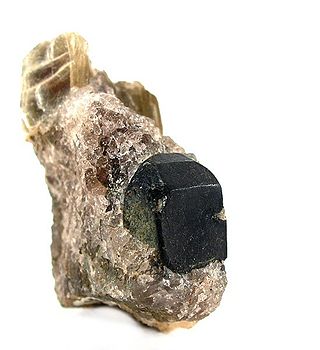
Triphylite is a lithium iron(II) phosphate mineral with the chemical formula LiFePO4. It is a member of the triphylite group and forms a complete solid solution series with the lithium manganese(II) phosphate, lithiophilite. Triphylite crystallizes in the orthorhombic crystal system. It rarely forms prismatic crystals and is more frequently found in hypidiomorphic rock. It is bluish- to greenish-gray in color, but upon alteration becomes brown to black.

Argyrodite is an uncommon silver germanium sulfide mineral with formula Ag8GeS6. The color is iron-black with a purplish tinge, and the luster metallic.

Zabuyelite is the natural mineral form of lithium carbonate, with a formula Li2CO3. It was discovered in 1987 at Lake Zabuye, Tibet, after which it is named. It forms colorless vitreous monoclinic crystals.

Eucryptite is a lithium bearing aluminium silicate mineral with formula LiAlSiO4. It crystallizes in the trigonal - rhombohedral crystal system. It typically occurs as granular to massive in form and may pseudomorphically replace spodumene. It has a brittle to conchoidal fracture and indistinct cleavage. It is transparent to translucent and varies from colorless to white to brown. It has a Mohs hardness of 6.5 and a specific gravity of 2.67. Optically it is uniaxial positive with refractive index values of nω = 1.570 - 1.573 and nε = 1.583 - 1.587.

The mineral zektzerite is a member of the tuhualite group and was first found in 1966 by Seattle mineralogist Benjamin Bartlett "Bart" Cannon. It was discovered in the Willow creek basin below Silver Star mountain in miarolitic cavities within the alkaline arfvedsonite granite phase of the Golden Horn batholith, Okanogan County, Washington. It is named for Jack Zektzer, mathematician and mineral collector of Seattle, Washington.
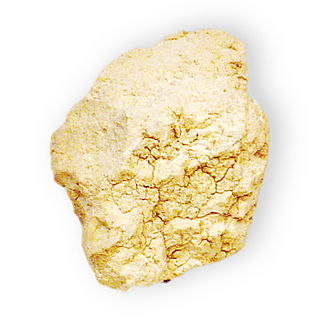
Hectorite is a rare soft, greasy, white clay mineral with a chemical formula of Na0.3(Mg,Li)3Si4O10(OH)2.

Jadarite is a white, earthy monoclinic silicate mineral, sodium lithium boron silicate hydroxide (LiNaSiB3O7(OH) or Na2OLi2O(SiO2)2(B2O3)3H2O).
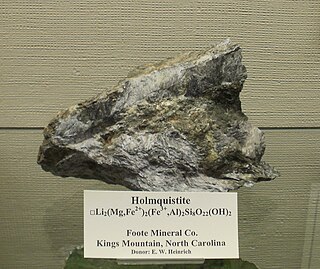
Holmquistite is a lithium magnesium aluminium inosilicate mineral with chemical formula Li2(Mg,Fe2+)3Al2Si8O22(OH)2. It crystallizes in the orthorhombic crystal system as prismatic crystals up to 10 cm (3.9 in) or as massive aggregates. It has a Mohs hardness of 5-6 and a specific gravity of 2.95 to 3.13.

Nambulite is a lithium bearing manganese silicate mineral with the chemical formula (Li,Na)Mn4Si5O14(OH). It is named after the mineralogist, Matsuo Nambu (born 1917) of Tohoko University, Japan, who is known for his research in manganese minerals. The mineral was first discovered in the Funakozawa Mine of northeastern Japan, a metasedimentary manganese ore.
Ferraioloite is a rare mineral with formula MgMn2+4(Fe2+0.5Al0.5)4Zn4(PO4)8(OH)4(H2O)20. It is related to the phosphate mineral falsterite. Ferraioloite was found in pegmatites of the Foote Lithium Company Mine, Cleveland County, North Carolina, US. The name honors James (Jim) A. Ferraiolo (1947–2014).
Faizievite is a very rare mineral with the formula K2Na(Ca6Na)Ti4Li6Si24O66F2. This triclinic mineral is chemically related to baratovite and katayamalite. Faizievite is a single-locality mineral, coming from the moraine of the Darai-Pioz glacier, Tien Shan Mountains, Tajikistan. Alkaline rocks of this site are famous for containing numerous rare minerals, often enriched in boron, caesium, lithium, titanium, rare earth elements, barium, and others.
References
- ↑ Warr, L.N. (2021). "IMA–CNMNC approved mineral symbols". Mineralogical Magazine. 85 (3): 291–320. Bibcode:2021MinM...85..291W. doi: 10.1180/mgm.2021.43 . S2CID 235729616.
- ↑ Mineralienatlas
- ↑ Mindat
- ↑ Webmineral data